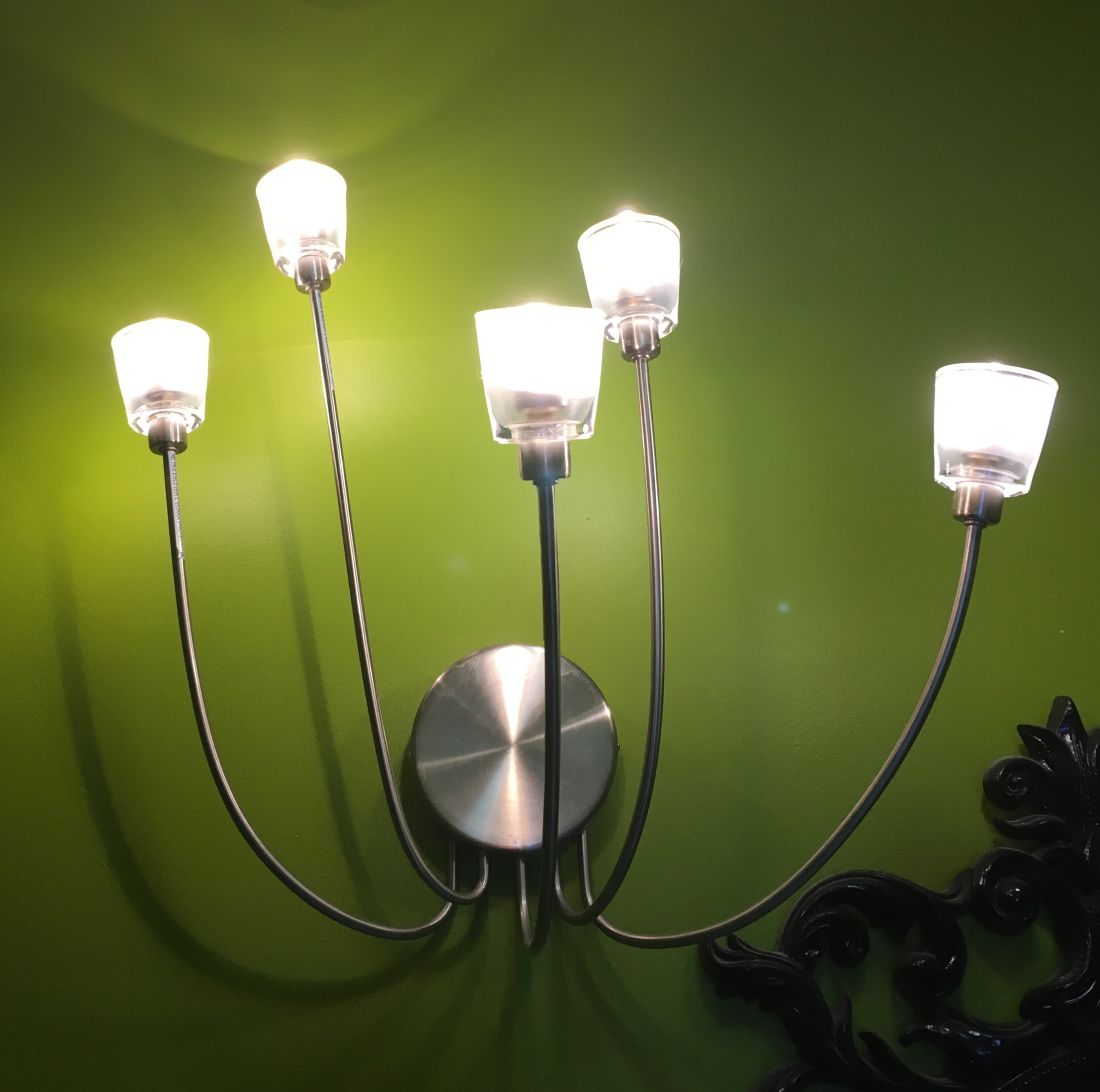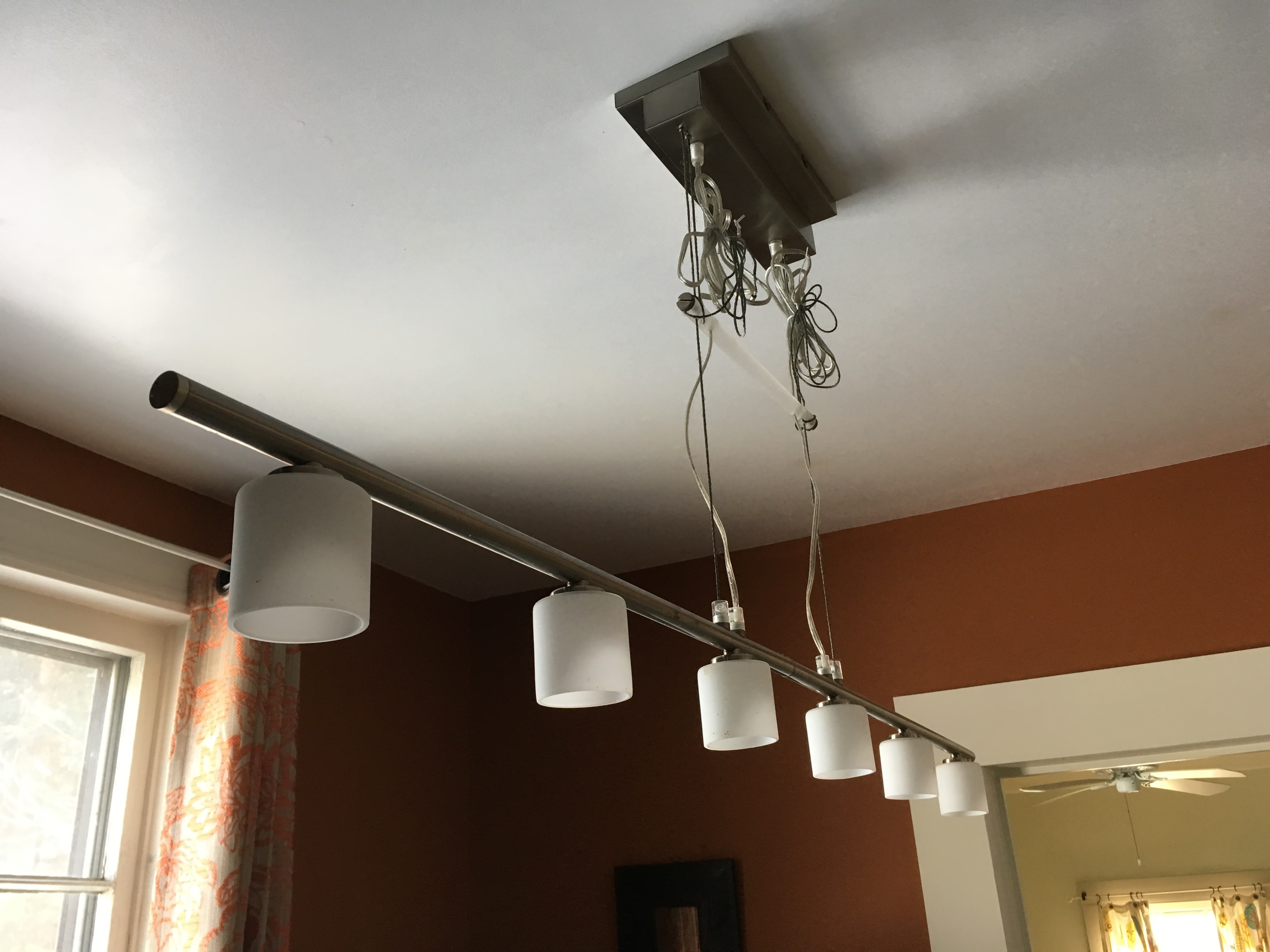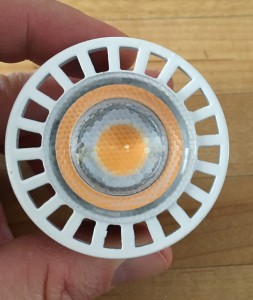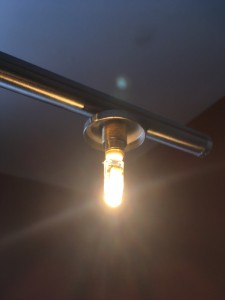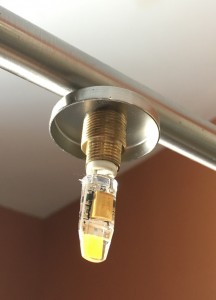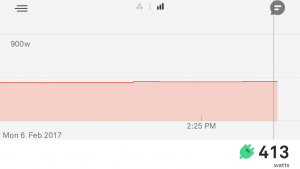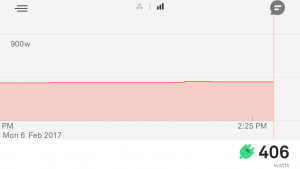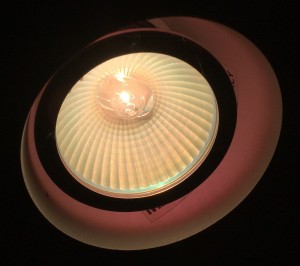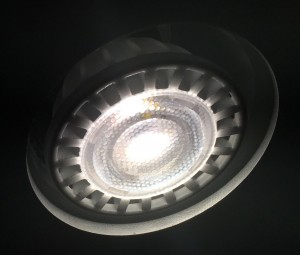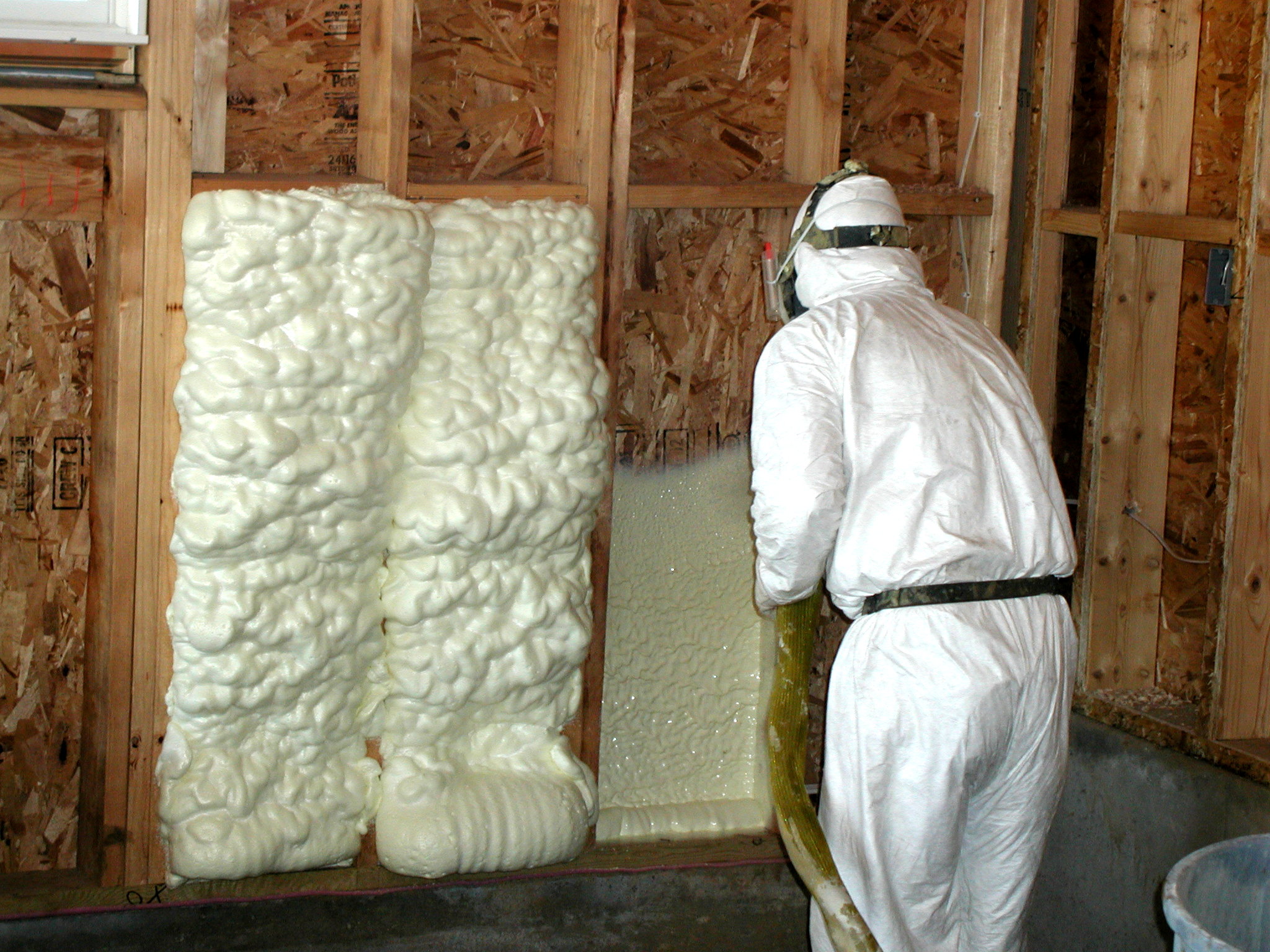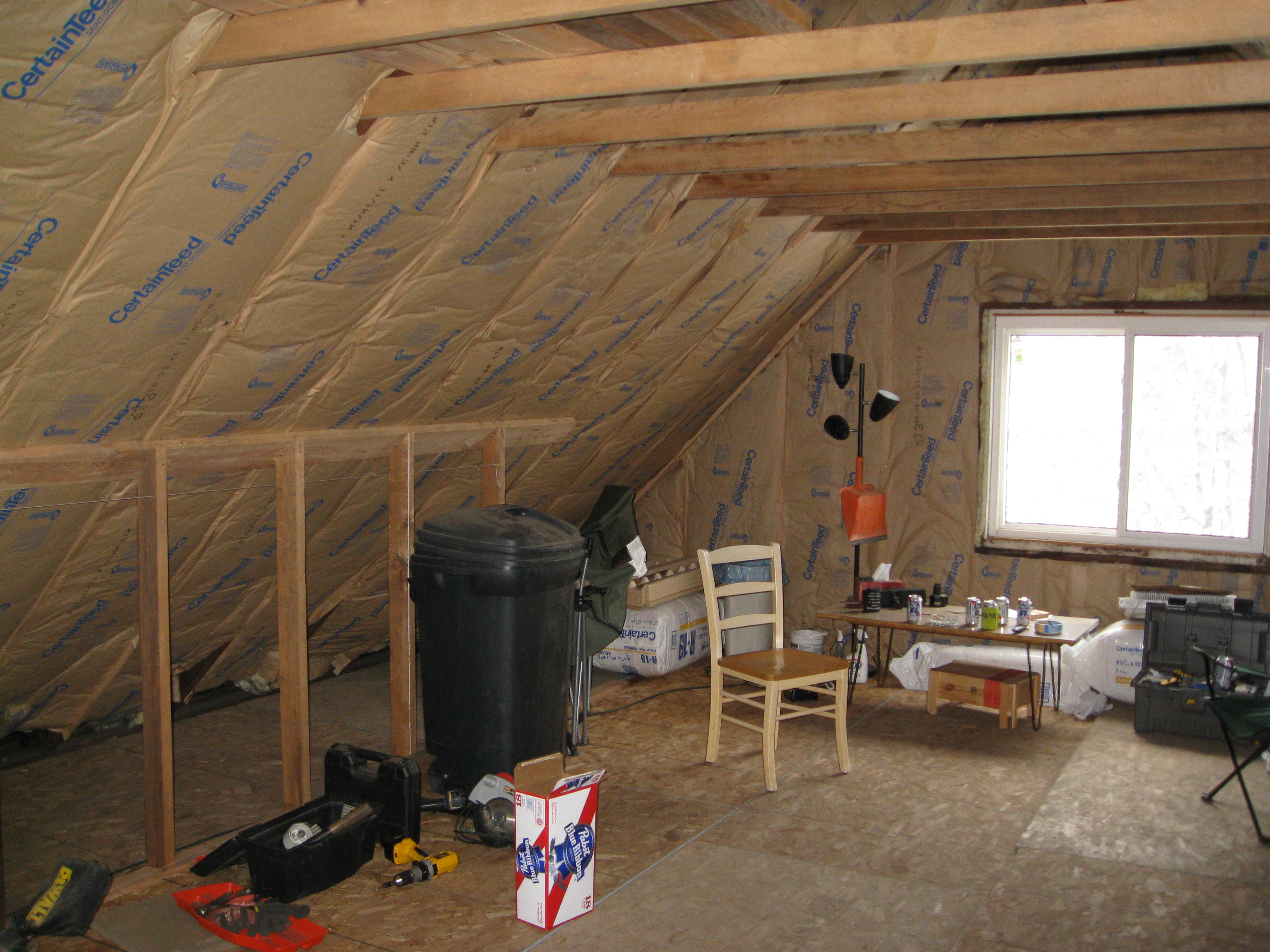Changing Halogen Track and IKEA Lighting to LED Bulbs (GU4, GU5.3, MR16 base)
If you have a few track lighting fixtures or IKEA light fixtures that use small halogen bulbs, there are finally decent to good LED replacements that use about 1/10th the energy but still make nice light. Here is the story of changing them and how much energy they saved.
I’ve changed all of the bulbs in my house to LEDs or CFLs (the squiggly ones.) Even the work light in the garage I barely use has an LED bulb. But I had a few light fixtures with halogen bulbs that needed to be changed, and they are ones that I use a lot. The last time I looked, there weren’t high quality bulbs that fit. There are now.
What I Changed:
I changed out 3 fixtures, the one in the image above is in a bathroom. Here are the other two:
This one is just off our kitchen in a converted porch we call the breakfast area. This fixture is on a lot in the early morning and evening. It has tiny bulbs with a 2 pin GU4 base. They are the same bulbs as the bathroom fixture above.
This IKEA track lighting fixture is in our finished basement. It’s always been rather dark down there, but I couldn’t put brighter bulbs in the fixture because it wasn’t rated for them. Thankfully LEDs put off a lot less heat, so I upgraded from 20 watt bulbs to 50 watt equivalents. It’s almost too bright now, but I don’t have to worry about finding another, brighter fixture for the space.
This IKEA track lighting fixture is in our finished basement. It’s always been rather dark down there, but I couldn’t put brighter bulbs in the fixture because it wasn’t rated for them. Thankfully LEDs put off a lot less heat, so I upgraded from 20 watt bulbs to 50 watt equivalents. It’s almost too bright now, but I don’t have to worry about finding another, brighter fixture for the space.
Trying to solve a comfort problem in your home?
The Home Comfort Book will help you avoid wasting thousands chasing symptoms by teaching you what root causes to problems are. The first chapter is available free here:
What to Look for in a Bulb
I’ll show you what I bought, but first there are two very important numbers to look for when buying light bulbs:
- 2700K – 2700 Kelvin is a color temperature. It’s pretty close to what incandescent or halogen bulbs put out. 5000K is more of a work light, 6500K is outdoor light on an overcast day. Buy 2700K, you’re pretty likely to like it. Or even lower if you can find it.
- 90+ CRI – Color Rendering Index is how well a bulb replicates an ideal light source, which is usually an incandescent bulb. 100 means 100% perfect color rendering. 80 or greater is decent, 90+ is excellent. If it’s not rated, the CRI probably stinks. Poor CRI means that skin tones and other colors will look “off.”
For more on buying bulbs, here is our free guide:
What I Bought
Yay Amazon! Delivering obscure stuff to your door every day. For the tiny little bulbs with the two pin GU4/G4 base, I picked this product:
They have the eye poppingly long description of “La Farah 1.2W G4 LED 12V AC/DC Bi-Pin Light Bulb 2700K Warm White Dimmable Waterproof T3 G4 Halogen 10W Led Replacement-Pack of 10.”
What it really means is that these are reasonably close to the color of incandescent bulbs. They use 1.2 watts instead of the 10 watts of the bulb I replaced. Color Rendering Index (CRI) isn’t mentioned anywhere, so I expected it to be mediocre. Here’s what they look like:
Yep, they’re kinda funky looking. They get buried inside the fixture, so I don’t really care. Remember, these are the evolution of the hard drive light that flashes at you, only much brighter.
For the larger bulbs on the basement fixture, here’s what I bought:
I was happy with what I saw. 2300K means they should be quite warm in color, so my hyper-sensitive graphic designer better half should like them ok. She only noted that they were bright. Which was also part of the plan. While I was stuck with 20 watt bulbs before, these are a 50 watt equivalent but only use 7 watts. Supposedly. I’ll show what they did in a bit. Here’s what the box looks like:
The bulb is ok looking, certainly far more normal than the “take me to your leader” look of the G4 base ones:
Installing the Bulbs and Energy Use
How many Home Performance experts does it take to change a light bulb? One. Bad joke. Sorry. Here is what the GU4/G4 base bulbs look like before/after and on/off:
Halogen Bulbs On/Off
LED Bulbs On/Off
When they’re on, just staring at the bulb the difference isn’t particularly obvious. During the day, I can’t tell the difference in the light. At night, though, they seem a little off. That makes sense since they didn’t have a CRI marking on them. They’ll work for now, but in time I’ll likely replace them. Hopefully my wife doesn’t notice the difference and make me change them. It’s happened plenty often before.
Energy Use of G4/GU4 Base Bulbs
If you’ve spent any time on this site, you know I’m a geek. I have not one, but two energy monitors in my electric box, a Curb and a Sense. I’ve come to like the Sense better (one of these days I’ll write up why, but easy install is the main thing, that said neither of them feels fully ready for primetime.)
The Sense is nice because it shows you a real-time chart of energy use and then flags differences. Here’s how much juice the 6 bulbs were using in the breakfast area fixture:
It’s a nice little display. I turned the light fixture on, usage went up 120 watts. I turned it off, usage went down 110, but then note the small stairstep right afterwards, the last 10 watts. So the fixture used to use 120 watts, quite a bit for a fixture we use at least a few hours per day. Here’s what happened afterwards:
The difference was so small that the Sense didn’t even call out a difference in usage. It’s about 7 watts, which is about right since each bulb is 1.2 watts and there are 6 of them. It could have been a bit more, the reading was swinging a few watts. Regardless, 7-8 watts down from 120 is pretty impressive, a 93-94% drop in usage for exactly the same job: lighting up our breakfast area. I was thrilled with the result.
Installing Track Lighting Bulbs with GU5.3/MR16 Base
Here’s what the bulbs in the basement track lighting fixture look like. Halogen on the left, LED on the right.
If you’ve bought LED replacement bulbs for recessed lights or spotlights, you’re used to this design. They swapped out easily, as you would expect.
Energy Use of GU5.3 MR16 Bulbs
Oi, it’s geeky to keep typing that, but I know it’s good for SEO, so I keep doing it… Anyway, here is what Sense showed for the 5 bulb fixture with 20 watt bulbs:

100 or 102 watts, right what was expected for 5 20 watt bulbs. I only bought a 4 pack, planning on seeing if I liked them well enough to buy more (I did, and I did.) Here’s what happened:
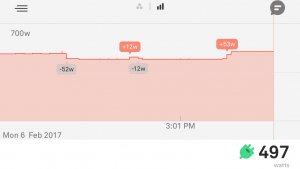
52 watts. Still a nice 50% drop. There are 4 7 watt LED bulbs and 1 20 watt halogen bulb, so it should be 28+20 = 48 watts. We already know the 5 halogen bulbs use 20 watts each. Those 7 watt bulbs look like they’re using 8. Shame shame. Actually, I don’t particularly care because they are more than twice as bright as the old ones. When I get them all replaced it will be 5×8 or 40 watts to get twice the light I got for 100 watts. I’ll take it!
Conclusion
Thinking about changing your bulbs? Just change the dumb things. It’s the only thing that actually “pays for itself” in my world. Those basement lights are on a lot, often 10 hours per day. I’ll likely see the effect from those bulbs alone in my electric bill, $2-3/month or so. It was about $20 for the pack, I’ll likely get my money back in a year, and I shouldn’t have to change those bulbs for at least 10 years. My office has another IKEA light fixture with 7 tiny G4 bulbs, those are up next.
Change any bulbs you use often for LEDs. Look for 2700K and 90+CRI. Better yet, download our free lighting guide to read more. Happy DIYing!
Trying to solve a comfort problem in your home?
The Home Comfort Book will help you avoid wasting thousands chasing symptoms by teaching you what root causes to problems are. The first chapter is available free here:
Post Script
I got a troubleshooting email from Hyperikon, the manufacturer of the MR16 bulbs, a few days after delivery. I consider that excellent customer service. Luckily, I had no issues, but it does bring up some points worth noting. Here is the email:
Dear Nate,
We are excited that you have decided to make the switch and go LED. The Hyperikon® MR16-series is a great choice!
The reason I am reaching out to you in this regard is to provide you with a troubleshooting guide in case you are experiencing issues with the bulbs. If they are already operating perfectly, simply disregard this e-mail.
Tracking lighting and various currents.
The current drawn by a LED 7W [MR16] remains very small regardless of the fixture. Consequently, this may result in the lack of compatibility from certain older transformers as well as older WAC tracks. If the bulb flickers a potential solution may be to (1) leave a single halogen bulb in the fixture/track or (2) Replace the transformer or dimmer.
Garage door interference
In some rare cases the FCC-approved frequency emitted by the MR16 collides with very few types of garage door openers. In this case please call us for a solution.
Dimming with LED bulbs
If your current setup includes a modern digital Lutron dimmer, you can expect a 100% dimming range from the Hyperikon® MR16. However, with older unadjusted dimmers you may not receive full dimmability (e.g. 50-100%). If you would like to retrieve full dimmability you can either (1) adjust the dimming capacitor range on the dimmer or (2) replace your current dimmer with one of the dimmers suggested from Hyperikon’s dimmability guide.
Should you experience any other issues other than the above, please do not hesitate to give us a call. Hyperikon’s 5 year unlimited warranty program will always keep you covered with replacements, technical support or instant refunds.
You can reach us at 888-846-4973.
All the best,
The Hyperikon Team
Get the HVAC Guide

It's free! Make buying a new furnace, air conditioner, or heat pump less stressful.


